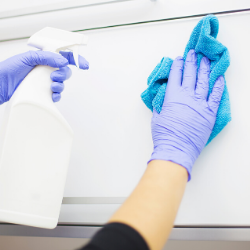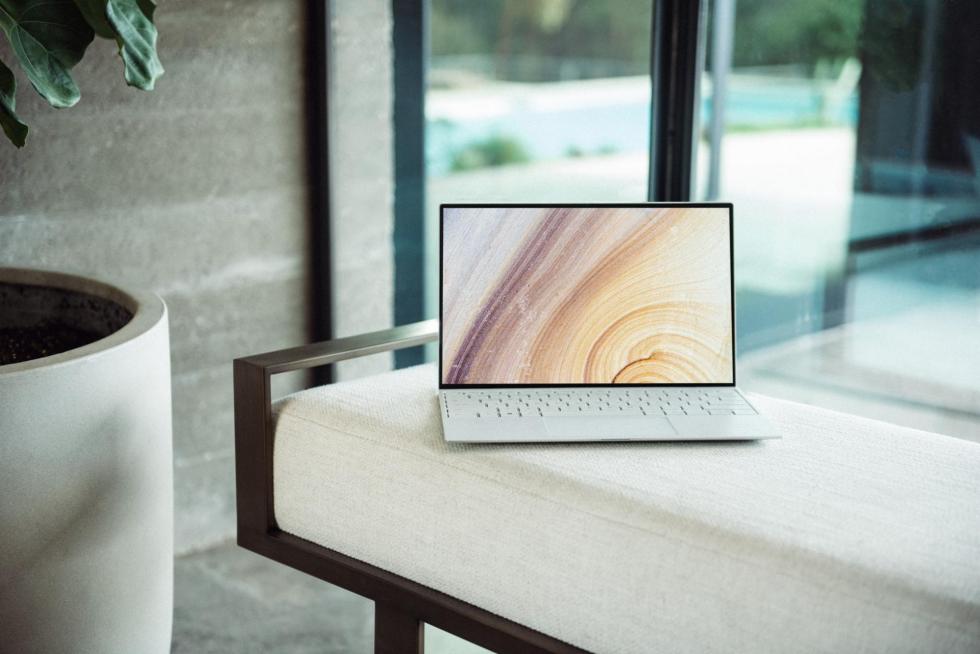Disinfection and Cleaning
Disinfection and Cleaning
Education leaders are revising existing procedures and protocols for cleaning, sanitizing and disinfecting school environments to ensure the safety of students, staff and visitors. Learn more about actions states, districts and schools can take to curb the spread of COVID-19.
Create and Revise Plans for Cleaning, Sanitization and Disinfection
In response to the COVID-19 pandemic, education leaders are revising existing procedures and protocols for cleaning, sanitizing and disinfecting school environments to ensure the safety of students, staff and visitors and align with guidelines, procedures and recommendations communicated by the CDC, the United States Environmental Protection Agency, the American Academy of Pediatrics and state and local health officials. SREB offers the following four actions to consider as schools and districts work to revise their procedures and protocols for cleaning, sanitizing and disinfecting.
1. Establish or enhance comprehensive procedures and protocols for cleaning, sanitizing and disinfecting school environments.
- Create a subcommittee or focus team to focus on cleaning, sanitization and disinfection procedures and protocols. Include community health liaisons, staff, teachers, administrators, students and parents. Use this group to complete the steps below and build an overall understanding of each procedure or protocol and explain the “whys” and “hows” of each. Task this group with developing communication tools and empower them to answer shareholder questions about cleaning, sanitization and disinfection.
- Begin by reviewing existing cleaning, sanitization and disinfection protocols or procedures. Compare existing procedures and protocols with guidelines provided by the CDC and local health authorities. Use a coding system to designate each procedure or protocol as fully aligned, partially aligned or not aligned with these guidelines. Those that are not fully aligned should be revised to reflect current expectations.
- Review guidance documents provided by the CDC and local health authorities and check which of their considerations or recommendations are addressed in existing procedures and protocols. Create a list of unaddressed considerations or recommendations. Use this list to expand or enhance procedures and protocols.
 Create an at-a-glance summary document that helps communicate new cleaning, sanitization and disinfection procedures and protocols and how they will be implemented. States, districts and schools can customize these summaries to include specific cleaning tasks by job function, setting — for example, shared spaces like gyms, locker rooms, band rooms, classrooms or offices — and frequency. Use this document to explain your approach and provide details that support implementation. If an area is missing from the sample list provided, create or revise existing procedures and protocols to be comprehensive.
Create an at-a-glance summary document that helps communicate new cleaning, sanitization and disinfection procedures and protocols and how they will be implemented. States, districts and schools can customize these summaries to include specific cleaning tasks by job function, setting — for example, shared spaces like gyms, locker rooms, band rooms, classrooms or offices — and frequency. Use this document to explain your approach and provide details that support implementation. If an area is missing from the sample list provided, create or revise existing procedures and protocols to be comprehensive.
- Complete a walkthrough of school facilities to verify that all areas are addressed in the plan. Use the walkthrough to identify high-touch areas that should be highlighted in procedures and protocols. Create a calendar that includes periodic walkthroughs to ensure that procedures and protocols are being implemented as designed. Consider building in additional time to clean, sanitize and disinfect school facilities, ensuring that instructional time is protected.
- Use the at-a-glance summary to update job duty descriptions or expectations of those who are responsible for managing and implementing procedures and protocols for cleaning, sanitizing and disinfecting school environments, such as janitorial staff, nutritional services staff, teachers and others. Consider making provisions for individual students, where appropriate or feasible, to assist with cleaning their desks or personal spaces.
- Create a protocol for handling books, devices, packets of assignments or lessons, and any other materials that students used while schools were closed or take home during when schools reopen.
- Use the at-a-glance summary to conduct periodic reviews of procedures and protocols to ensure their effectiveness. Use the reviews to ensure fidelity of implementation and adjust procedures and protocols as needed to increase efficiency and effectiveness.
South Carolina’s AccelerateED Task Force published Summer Learning & Operations Recommendations that include health screening and sanitation practices recommended by the South Carolina Department of Health and Environmental Control.
2. Secure and manage selected cleaning resources.
- Use the sample at-a-glance summary to compile a list of needed cleaning, sanitizing and disinfecting products for school or district offices. Cross-reference the list with products meeting the United States Environmental Protection Agency disinfection criteria and seek input from state or local health departments and risk management personnel. Determine which products or chemicals should be banned from use — including those that cannot be used due to staff or student chemical sensitivities or allergies. Clearly communicate to students, parents, teachers and other school personnel which products may or may not be brought from home for in-school use, as well as why certain products have been banned or may have only limited use.
Consider including the following in the list of products:- Selected product(s)
- Alternate product(s) to be used in cases of shortage or limited access to preferred products
- Quantity needed for a three- to six-month supply
- Vendor(s) and vendor contact information
- Determine a product management and distribution plan that addresses how products will be distributed, stored and managed. Determine who will be responsible for managing the product inventory and ensuring that cleaning and disinfection products are safely and securely stored away from children.
- Contact state or regional purchasing officers to determine if selected products can be purchased using a state negotiated price agreement or bulk discount. Work within regional networks to determine shared needs and complete the action steps to establish new statewide pricing agreements for high-need items.
- Determine policies and guidelines for the use of cleaning and sanitizing products that are not provided by the district or school, such as hand sanitizers or cleaning supplies brought in to the school by teachers or students. Consider whether outside supplies will be allowed. Clearly outline which products are allowed and proper procedures for using them.
- Provide staff with the list of banned items, clearly communicating why they have banned from use and providing reminders about respecting the needs of students and staff with chemical sensitivities and ensuring that products are used with proper ventilation.
3. Launch a personal hygiene campaign.
Use CDC and local health resources to teach and promote healthy hand-washing hygiene. Place “how to” posters near hand-washing stations and make hand-washing part of daily routines on campus, when entering a facility from home, before and after meals, when touching or using shared resources, and other contexts. If hand-washing stations are not available, communicate and support the use of approved hand sanitizers.
- Educate and promote the use of appropriate respiratory etiquette, especially the use of face coverings. Educate students and staff about expectations for when and where they should use face coverings. Support students and staff in understanding practices that limit the spread of germs, such as coughing or sneezing into a clothed elbow, safely disposing of used tissues and immediate washing one’s hands after discarding a tissue.
- Consider creating videos that show students and parents what new health, safety and hygiene practices look like in action in different settings, such as on the bus, in the classroom, in shared spaces and hallways, at mealtimes and during extracurricular activities. Share videos on social media platforms, websites and local TV channels.
4. Promote the comprehensive cleaning, sanitization and disinfection plan.
Community members, families and staff need to thoroughly understand the comprehensive cleaning, sanitization and disinfection plan. Use varied communication tools to showcase the plan and illustrate how it will ensure the health and safety of the school community.
- Publicize cleaning, sanitization and disinfection practices. Use colorful handouts, website features, news releases, emails and videos to showcase how the district or school is preparing a clean and safe environment for students. Showcase practices that will be used to keep the school community safe from COVID-19. Enlist community leaders who can serve as ambassadors for your practices.
- Plan virtual kick-off events to demonstrate procedures and protocols. Use a town-hall format to engage school and community shareholders in discussions about cleaning, sanitization and disinfection practices. Invite local health officials to serve as guest speakers who can reinforce the need for such practices. Use these meetings to showcase how day-to-day activities in the school will be different and gather questions that can help further refine the plan for cleaning, disinfecting and sanitizing the school environment.
- Create a schedule of “welcome back” events for students and staff. Create a schedule of events that allows smaller groups of students and staff to enter facilities and learn about site-based cleaning practices. Use these events as orientations and teach expected cleaning and hygiene protocols.
- Conduct formal training for faculty and staff. Provide faculty and staff with written copies of cleaning, sanitizing and disinfection procedures and protocols. Conduct training on procedures and protocols by job type, such as for teachers, bus drivers, janitorial staff, cafeteria workers, office staff and others. Provide faculty and staff with a list of cleaning dos and don’ts to ensure that expectations are followed and students or staff with chemical sensitivities are not exposed to potentially harmful fumes or products.
- Celebrate work and publicize outcomes. Continue educating students and staff after school begins. Showcase successes from early implementation. Communicate needed adjustments to the plan and provide opportunities for the community to give feedback.
Louisiana published guidance on reopening that focuses specifically on K-12 summer activities. Louisiana’s reopening plan outlines a set of phases that are initiated once certain public health criteria are met. Restrictions will be gradually relaxed as these phases progress, allowing greater flexibility.
Read the notice about SREB’s K-12 Education Recovery Playbook.



